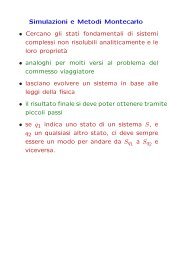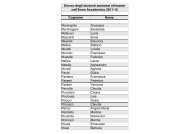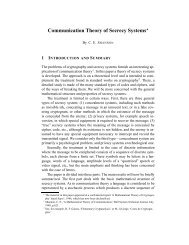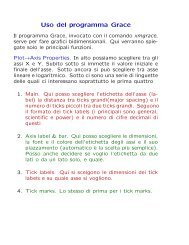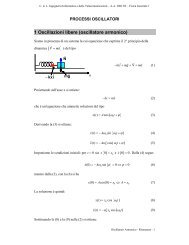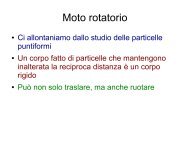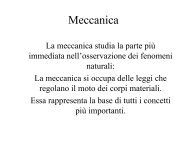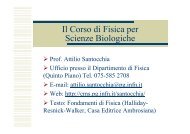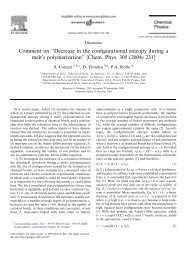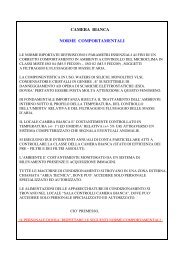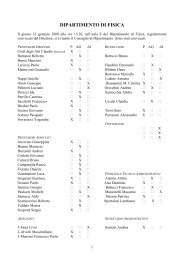Two crossover regions in the dynamics of glass forming ... - Fisica
Two crossover regions in the dynamics of glass forming ... - Fisica
Two crossover regions in the dynamics of glass forming ... - Fisica
You also want an ePaper? Increase the reach of your titles
YUMPU automatically turns print PDFs into web optimized ePapers that Google loves.
J. Chem. Phys., Vol. 117, No. 5, 1 August 2002 <strong>Two</strong> <strong>crossover</strong> <strong>regions</strong> <strong>in</strong> <strong>the</strong> <strong>dynamics</strong> <strong>of</strong> epoxy res<strong>in</strong>s<br />
FIG. 7. a Arrhenius plot for DGEBA. The temperature dependence <strong>of</strong> <strong>the</strong><br />
dynamic <strong>glass</strong> transition is reconstructed via <strong>the</strong> trace <strong>of</strong> max(2f max) 1<br />
from open circles and c p solid triangles, and via <strong>the</strong> viscosity data<br />
<strong>the</strong> solid l<strong>in</strong>e shows experimental data <strong>of</strong> log( 1 ), with log 8.4 and <br />
<strong>in</strong> Pa s, also <strong>in</strong>clud<strong>in</strong>g data from Ref. 36. The dielectric - and -relaxation<br />
times are reported with diamond and squares, respectively. The dashed l<strong>in</strong>e<br />
is an Arrhenius fit to <strong>the</strong> TT g relaxation data log 0 s14.35<br />
0.13, E a6.60.1 kcal/mol; its extrapolation above T g is drawn with a<br />
dotted l<strong>in</strong>e. The dash-dotted l<strong>in</strong>e is an Arrhenius fit to <strong>the</strong> relaxation<br />
data log 0 s14.780.09, E a11.380.08 kcal/mol. The - and<br />
-<strong>crossover</strong> <strong>regions</strong> are <strong>in</strong>dicated by arrows. b Temperature dependence <strong>of</strong><br />
<strong>the</strong> dielectric strengths <strong>of</strong> DGEBA. The <strong>in</strong>set shows circles and <br />
down triangles above T g , and <strong>the</strong> calorimetric <strong>in</strong>tensity c p up triangles,<br />
<strong>in</strong> units J kg 1 K 1 . The solid l<strong>in</strong>e is a l<strong>in</strong>ear fit to , extrapolated<br />
to <strong>the</strong> onset temperature T on . The dashed l<strong>in</strong>e is drawn as a guide to<br />
<strong>the</strong> eyes. Error bars smaller than <strong>the</strong> symbol size are omitted.<br />
perimental time scale. The characteristic time (T g) may<br />
strongly depend on <strong>the</strong> experimental probe used and on <strong>the</strong><br />
cool<strong>in</strong>g rate; <strong>in</strong> particular, <strong>in</strong> a typical dielectric experiment<br />
<strong>the</strong> out-<strong>of</strong>-equilibrium state occurs when <strong>the</strong> structural relaxation<br />
time approximately exceeds 10 2 s. The dielectric value<br />
<strong>of</strong> T g calculated <strong>in</strong> our samples by follow<strong>in</strong>g this criterion is<br />
given <strong>in</strong> <strong>the</strong> second column <strong>of</strong> Table II, where good agreement<br />
with <strong>the</strong> calorimetric value from conventional DSC can<br />
be noticed. Also <strong>in</strong>cluded <strong>in</strong> Table II is <strong>the</strong> steepness <strong>in</strong>dex<br />
md(log )/d(T g /T) TTg , which quantifies <strong>the</strong> fragility <strong>of</strong><br />
<strong>the</strong> system <strong>in</strong> terms <strong>of</strong> its temperature behavior at T g .<br />
At lower temperatures <strong>the</strong> system is <strong>in</strong> <strong>the</strong> nonequilibrium<br />
<strong>glass</strong>y state. There, two secondary processes and <br />
process coexist, both show<strong>in</strong>g Arrhenius behavior. The correspond<strong>in</strong>g<br />
fitt<strong>in</strong>g parameters are listed <strong>in</strong> Table III. The dotted<br />
segment <strong>in</strong> Figs. 6a and 7a shows that at temperatures<br />
higher than T g <strong>the</strong> trace deviates significantly from <strong>the</strong><br />
extrapolation <strong>of</strong> <strong>the</strong> behavior below T g . In particular, it first<br />
becomes flatter i.e., lower apparent activation energy and<br />
<strong>the</strong>n goes on with <strong>in</strong>creas<strong>in</strong>g slope i.e., <strong>in</strong>creas<strong>in</strong>g apparent<br />
activation energy, which becomes comparable to that found<br />
below T g . Different approaches for analyz<strong>in</strong>g relaxation<br />
functions <strong>in</strong> <strong>the</strong> case <strong>of</strong> <strong>the</strong> overlap <strong>of</strong> <strong>the</strong> two processes are<br />
debated <strong>in</strong> literature, 41–47 and <strong>the</strong>ir repercussions are especially<br />
expected <strong>in</strong> <strong>the</strong> Arrhenius diagram <strong>in</strong> <strong>the</strong> region where<br />
2441<br />
FIG. 8. Ma<strong>in</strong> frame: dielectric relaxation time max vs viscosity <strong>in</strong> a<br />
log–log representation, where <strong>the</strong> relation max corresponds to a l<strong>in</strong>ear<br />
behavior with slope 1. a The solid l<strong>in</strong>e slope 0.990.02 is a l<strong>in</strong>ear fit to<br />
<strong>the</strong> data <strong>of</strong> PPGE over six decades, <strong>in</strong> <strong>the</strong> temperature range 276–332 K. b<br />
The straight l<strong>in</strong>e slope 0.980.02 is a l<strong>in</strong>ear fit to <strong>the</strong> data <strong>of</strong> DGEBA over<br />
ten decades, <strong>in</strong> <strong>the</strong> temperature range 256–343 K. Inset: Conductivity vs<br />
reciprocal viscosity 1 <strong>in</strong> a log–log representation. The straight l<strong>in</strong>es are<br />
fits <strong>of</strong> <strong>the</strong> relation n const. a The fitt<strong>in</strong>g l<strong>in</strong>e corresponds to n0.77<br />
0.03 <strong>in</strong> <strong>the</strong> lower-temperature range solid l<strong>in</strong>e and n0.940.03 <strong>in</strong> <strong>the</strong><br />
higher-temperature range dashed l<strong>in</strong>e for PPGE, and b to n1.02<br />
0.03 <strong>in</strong> <strong>the</strong> temperature range 300–378 K for DGEBA. Data correspond<strong>in</strong>g<br />
to characteristic temperatures are <strong>in</strong>dicated for <strong>the</strong> mean<strong>in</strong>g <strong>of</strong> T and<br />
T on see text.<br />
<strong>the</strong> processes tend to merge. Then we cannot completely rule<br />
out <strong>the</strong> possibility <strong>of</strong> some <strong>in</strong>fluence <strong>of</strong> <strong>the</strong> analysis method<br />
on <strong>the</strong> higher temperature values. However, such an <strong>in</strong>fluence<br />
does not affect <strong>the</strong> data for <strong>the</strong> relaxation <strong>in</strong> <strong>the</strong><br />
region where <strong>the</strong> separation from <strong>the</strong> process is two decades<br />
at least, s<strong>in</strong>ce under this condition an analysis <strong>of</strong> <strong>the</strong><br />
separation us<strong>in</strong>g <strong>the</strong> additive ansatz is always<br />
justified. 43,44,46 In particular, we notice that a deviation from<br />
<strong>the</strong> extrapolated Arrhenius behavior <strong>of</strong> <strong>the</strong> trace occurs just<br />
above T g where <strong>the</strong> separation <strong>of</strong> <strong>the</strong> and time scales is<br />
nearly ten decades, and this is actually confirmed by deconvolut<strong>in</strong>g<br />
<strong>the</strong> and processes accord<strong>in</strong>g to alternative fitt<strong>in</strong>g<br />
procedures 48,49 based on <strong>the</strong> Williams ansatz. 41–47 Moreover,<br />
<strong>the</strong> effect <strong>of</strong> different fitt<strong>in</strong>g approaches on <strong>the</strong> relaxation<br />
time values at higher temperatures has been proven 48 not to<br />
affect qualitatively <strong>the</strong> trend <strong>of</strong> (T), and we have no reason<br />
to th<strong>in</strong>k also <strong>the</strong> higher-temperature bend<strong>in</strong>g <strong>of</strong> <strong>the</strong> <br />
trace to be an artifact <strong>of</strong> <strong>the</strong> evaluation method.<br />
Also <strong>the</strong> dc conductivity, , can be used as an efficient<br />
probe <strong>of</strong> <strong>the</strong> <strong>dynamics</strong> <strong>of</strong> supercooled systems. It should be<br />
noted that different samples <strong>of</strong> <strong>the</strong> same material might show<br />
different absolute values, s<strong>in</strong>ce this is proportional to <strong>the</strong><br />
amount <strong>of</strong> impurities <strong>in</strong> <strong>the</strong> sample typically chlor<strong>in</strong>e, <strong>in</strong><br />
epoxy compounds. However, <strong>the</strong> temperature dependence <strong>of</strong><br />
Downloaded 14 Nov 2002 to 194.95.63.241. Redistribution subject to AIP license or copyright, see http://ojps.aip.org/jcpo/jcpcr.jsp



